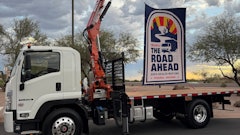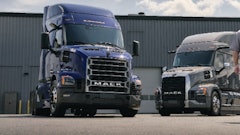
There are basically four types of drive axle suspension systems for medium- and heavy-duty trucks: rigid mount, steel leaf springs, rubber blocks and air ride. The choice between systems directly impacts the vehicle's ride quality, roll stability, durability, mobility and handling. To maximize productivity and safety, you must understand the trade-offs.
No system works well in every application. "As with almost every truck spec'ing question, the answer is that it depends," says Brian Lindgren, vocational sales director, Kenworth. You must decide which attributes are most important in your application.
On construction sites, one of the most difficult trade-offs is between the feel of the ride and handling. "You are always making a choice between ride quality and roll stability," says Steven Ferro, lead design engineer, medium-duty suspension systems, General Motors.
Suspension designers must pick and choose which conflicting attributes a given suspension system will emphasize. "Roll stability and articulation often work against one another," says Lindgren. "Durability tends to be a trade-off with weight —the heavier ones can be built with more metal so they last longer. Handling, in most cases, comes as a function of roll stability."
Operation in rough, uneven terrain requires different suspension solutions than those running on well-graded jobsites. "If you need a suspension that has extreme articulation because you are going into a site that large earthmovers have just been through, then you might have to trade off more of a lightweight design to get one that has the utmost in articulation," says Matt Stevenson, product marketing manager, Sterling and Western Star Trucks. Cost is also an issue that results in trade-offs.
Even regional regulations affect your choice. "In the eastern United States, customers demand a more robust specification for duty that certainly will weigh more than a similar application in, say California, where weight is the primary driver of the spec," explains David McKenna, product manager, Mack Engines, Transmissions & Axles.
But there has been a shift in the types of suspension systems preferred by vocational customers. "If we go back in history, virtually all trucks were on some kind of a steel spring," recalls Lindgren. "Then rubber started making inroads. About five years ago, it was about one-third steel spring, one-third rubber and one-third air for vocational trucks." And the market continues to shift. "It seems to be settling out to either rubber or air."
Rigid suspensions offer stability
Rigid suspensions have advantages in terms of simplicity, durability and stability, but they offer poor ride quality.
Optimally, a rigid beam suspension will be the lightest and most stable," says McKenna. "It will also be the roughest ride laden and un-laden."
Lindgren adds, "If you went to the old Hendrickson R suspension systems that didn't have any springs, that is the best in roll stability." But you probably would not enjoy the ride quality.
Leaf springs prove cost effective
The leaf spring suspension is a good fit for anyone who places a premium on the initial purchase price. "It is the lowest cost," says Ferro.
In addition, leaf spring suspensions typically offer good articulation for negotiating uneven terrain. "The leaf spring with torque rod design or some of the lighter weight rubber block suspensions with torque rods usually offer the best articulation," says Stevenson.
This prevents the suspension from bottoming out. "When a suspension bottoms out, that invariably means that one axle is no longer in contact with the ground, causing wheel spin," says McKenna. "Depending upon wheel speed, when that end regains traction, this could be very costly." This favors systems with good articulation, such as the leaf spring rrangements.
Ground clearance is also important in these environments. "That is the single most significant reason that Mack has top-loading rear axle carriers that greatly increase ground clearance and keep the driveline angles straight," says McKenna.
While leaf spring suspensions are designed to provide comfort while loaded, the ride can sometimes be harsh when operating without a load. "Depending upon the type of leaf spring, it can offer poor ride quality, especially when you look at an unloaded situation," says Stevenson. "They are optimized for comfort under load. People sometimes forget the trucks are running pretty much the same amount of time loaded as they are unloaded."
For service and lube trucks, unladen ride quality is not as much of an issue. These trucks are usually laden.
Steel leaf springs also have a weight disadvantage. "The rubber and the air springs can be built lighter than the steel leaf springs," explains Lindgren. "It impacts how much you can haul. If you can haul a little bit more, you can usually get a little bit better revenue. So weight becomes very important."
Good articulation does not usually go hand in hand with good roll stability, but leaf springs can provide good roll control if they are properly outfitted. "The leaf suspension is pretty good in roll stiffness as long as you add certain things, such as a stabilizer bar," says Ferro.
The Sterling TufTrac is an example of a leaf spring suspension with a torque rod. This type of setup maintains a uniform load over each wheel as the suspension articulates, and its design is much lighter than some leaf spring and even some rubber block designs.
Mack Trucks has found its Camelback leaf spring suspension is a popular choice for the construction market. "Primarily, it has a parallelogram design, meaning the spring centers can adjust from end to end to aid in equalizing ground pressure and, most importantly, allowing the bogie to steer around a corner and not drag the rear-most axle, scrubbing off very expensive rubber," says McKenna. "We offer an Anti-Sway spring pack that has increasing spring leaf thickness as the spring leaf gets progressively shorter —in effect, giving the entire spring pack stability through the entire load and unload cycle, resulting in good ride quality, loaded or empty." It weighs more than a rubber block suspension, but offers good ride, stability and tire wear at an affordable price.
Rubber blocks offer compromise
"One of the advantages of a rubber block [suspension] is it is pretty consistent in terms of its roll stability," says Stevenson.
Ferro agrees, noting, "The rubber block suspension has inherent lateral stiffness and roll stiffness."
Rubber springs can also be tuned for increased ride quality. "It is easier to get a variable spring rate with a rubber suspension than it is with a steel leaf spring," says Lindgren. "Steel leaf springs typically have a linear spring rate."
"At General Motors, a lot more of our customers are requesting the rubber blocks just because of the better ride and roll control," says Ferro.
Increased ride quality and roll stiffness make rubber block suspensions especially popular with dump truck operators. "For Kenworth, we typically recommend using the Chalmers or Hendrickson HAULMAAX suspensions," says Lindgren.
A disadvantage of a rubber block suspension is its higher initial cost compared to leaf spring suspensions, notes Ferro. In addition, the ride quality of the rubber block typically is not as good as air ride suspensions.
Air ride gains popularity
The demand for improved ride quality is driving the development of air suspensions. "There is probably more development money spent on air suspension systems than any other kind," says Lindgren. "That appears to be the direction of the future. We are seeing air suspensions being specifically designed for vocational applications."
In the past, some on-highway air suspensions were pressed into off-road service. This created articulation, stability and durability issues with the air bags. But times have changed. "The Sterling AirLiner is specifically designed for vocational applications, as opposed to in the past where you had highway air suspensions being put in vocational applications," says Stevenson.
Lindgren reports that Kenworth also has a series of air suspensions designed specifically to tackle vocational applications.
Air suspensions typically offer the best ride quality. "The air ride provides a good ride, whether it is laden or unladen," says Ferro.
This translates into greater productivity. "You reduce driver fatigue," Ferro explains. "You can stay in the vehicle longer without getting tired."
"Air ride is the standard when it comes to ride quality, but suspension suppliers have really made strides on leaf spring and some of the rubber block torque rod designs," says Stevenson. "They are getting real close to air ride without having the worries that air ride can provide in terms of stability and also articulation."
In terms of weight savings, it is hard to match the air ride suspension. "There is just not as much metal in the air suspension as you would have in the rubber block or leaf spring," says Ferro.
"The challenge with an air suspension is getting good articulation and keeping adequate roll stiffness," says Lindgren. "You tend to trade those off against one another."
Articulation still favors the walking beam suspensions. "The best of the walking-beam suspensions, whether they are rubber or steel, do better than the best of the air suspensions so far," says Lindgren.
Stevenson claims the Hendrickson HAULMAAX, which is a rubber block suspension with a torque rod, and the Sterling TufTrac leaf-spring suspension with a torque rod are among the leaders in terms of articulation. They offer from 17.5 to 18 in. of cross-directional motion.
In terms of roll stiffness with air ride suspensions, it really varies by design. "There are some misconceptions about air suspensions and roll stiffness," says Lindgren. "Some air suspensions are very good and some are not very good, so you cannot generalize all of them into one category."
But an air suspension might not be the best choice for high center-of-gravity (cg) loads. "Certainly, air ride is by far the smoothest, but by its very nature it is not very stable with a high cg load," says McKenna. "That is exacerbated by uneven and loose ground cover."
One example is when a dump body is hoisted. "In dump truck applications, you have to dump the air bags before you get that body in the air," says Stevenson. "It just becomes another item that a construction fleet owner or supervisor has to worry about —making sure his guys are dumping the air out of the air bags before they dump a load. If you are running air ride, you definitely have to be confident in the operators of your units."
As with the rubber block suspension, cost can be an issue with the air ride. "It is in the same price range as rubber block for the initial cost," says Ferro.
On shorter wheelbase medium-duty trucks, there can also be an issue with the available space. "You are looking for locations for the air reservoir and the air ride itself, as well as the air brake. So real estate, especially underneath the truck, becomes a premium," says Ferro. "In the shorter wheelbases, it becomes very difficult to find that real estate."
But for the future, air suspension seems to hold the most promise. "The air suspensions, especially some of the later designs, are getting better and better," says Stevenson.




















